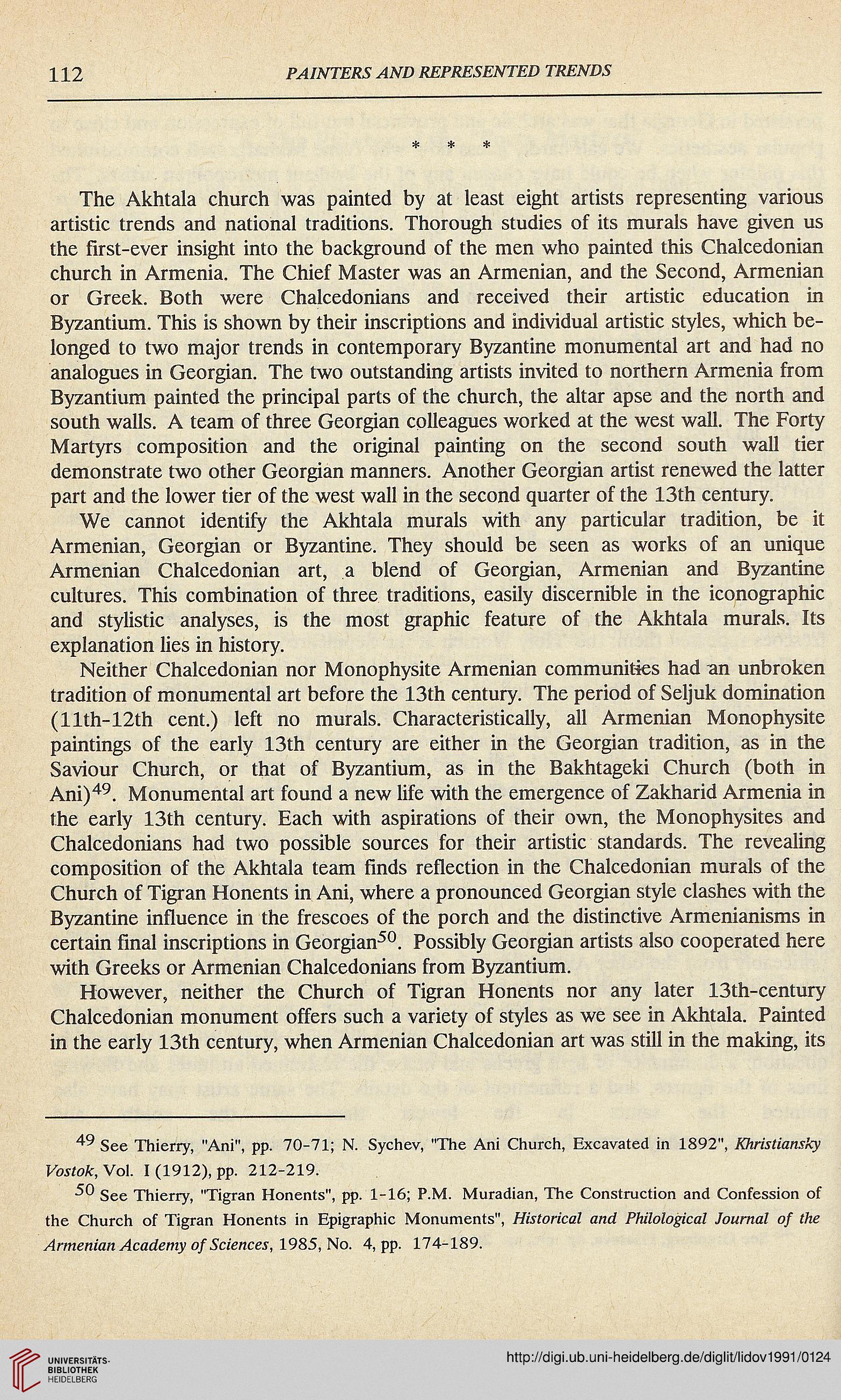112
*
*
The Akhtala church was painted by at ieast eight artists representing various
artistic trends and nationai traditions. Thorough studies of its murals have given us
the first-ever insight into the background of the men who painted this Chalcedonian
church in Armenia. The Chief Master was an Armenian, and the Second, Armenian
or Greek. Both were Chalcedonians and received their artistic education in
Byzantium. This is shown by their inscriptions and individual artistic styles, which be-
longed to two major trends in contemporary Byzantine monumental art and had no
analogues in Georgian. The two outstanding artists invited to northern Armenia from
Byzantium painted the principal parts of the church, the altar apse and the north and
south walls. A team of three Georgian colleagues worked at the west wall. The Forty
Martyrs composition and the original painting on the second south wall tier
demonstrate two other Georgian manners. Another Georgian artist renewed the latter
part and the lower tier of the west wall in the second quarter of the 13th century.
We cannot identify the Akhtala murals with any particular tradition, be it
Armenian, Georgian or Byzantine. They should be seen as works of an unique
Armenian Chalcedonian art, a blend of Georgian, Armenian and Byzantine
cultures. This combination of three traditions, easily discernible in the iconographic
and stylistic analyses, is the most graphic feature of the Akhtala murals. Its
explanation lies in history.
Neither Chalcedonian nor Monophysite Armenian communities had un unbroken
tradition of monumental art before the 13th century. The period of Seljuk domination
(llth-12th cent.) left no murals. Characteristically, all Armenian Monophysite
paintings of the early 13th century are either in the Georgian tradition, as in the
Saviour Church, or that of Byzantium, as in the Bakhtageki Church (both in
Ani)49. Monumental art found a new life with the emergence of Zakharid Armenia in
the early 13th century. Each with aspirations of their own, the Monophysites and
Chalcedonians had two possible sources for their artistic standards. The revealing
composition of the Akhtala team finds reflection in the Chalcedonian murals of the
Church of Tigran Honents in Ani, where a pronounced Georgian style clashes with the
Byzantine influence in the frescoes of the porch and the distinctive Armenianisms in
certain final inscriptions in Georgian^. Possibly Georgian artists also cooperated here
with Greeks or Armenian Chalcedonians from Byzantium.
However, neither the Church of Tigran Honents nor any later 13th-century
Chalcedonian monument offers such a variety of styles as we see in Akhtala. Painted
in the early 13th century, when Armenian Chalcedonian art was still in the making, its
49 See Thierry, "Ani", pp. 70-71; N. Sychev, "The Ani Church, Excavated in 1892", XAr/jdanrAy
EoytoAr, Voi. !(1912), pp. 212-219.
See Thierry, "Tigran Honents", pp. 1-16; P.M. Muradian, The Construction and Confession of
the Church of Tigran Honents in Bpigraphic Monuments", /Aslon'co/ and PMo/ogica/ /oarna/ o/
Ar/Hentan Academy o/.Sciences', 1985, No. 4, pp. 174-189.
*
*
The Akhtala church was painted by at ieast eight artists representing various
artistic trends and nationai traditions. Thorough studies of its murals have given us
the first-ever insight into the background of the men who painted this Chalcedonian
church in Armenia. The Chief Master was an Armenian, and the Second, Armenian
or Greek. Both were Chalcedonians and received their artistic education in
Byzantium. This is shown by their inscriptions and individual artistic styles, which be-
longed to two major trends in contemporary Byzantine monumental art and had no
analogues in Georgian. The two outstanding artists invited to northern Armenia from
Byzantium painted the principal parts of the church, the altar apse and the north and
south walls. A team of three Georgian colleagues worked at the west wall. The Forty
Martyrs composition and the original painting on the second south wall tier
demonstrate two other Georgian manners. Another Georgian artist renewed the latter
part and the lower tier of the west wall in the second quarter of the 13th century.
We cannot identify the Akhtala murals with any particular tradition, be it
Armenian, Georgian or Byzantine. They should be seen as works of an unique
Armenian Chalcedonian art, a blend of Georgian, Armenian and Byzantine
cultures. This combination of three traditions, easily discernible in the iconographic
and stylistic analyses, is the most graphic feature of the Akhtala murals. Its
explanation lies in history.
Neither Chalcedonian nor Monophysite Armenian communities had un unbroken
tradition of monumental art before the 13th century. The period of Seljuk domination
(llth-12th cent.) left no murals. Characteristically, all Armenian Monophysite
paintings of the early 13th century are either in the Georgian tradition, as in the
Saviour Church, or that of Byzantium, as in the Bakhtageki Church (both in
Ani)49. Monumental art found a new life with the emergence of Zakharid Armenia in
the early 13th century. Each with aspirations of their own, the Monophysites and
Chalcedonians had two possible sources for their artistic standards. The revealing
composition of the Akhtala team finds reflection in the Chalcedonian murals of the
Church of Tigran Honents in Ani, where a pronounced Georgian style clashes with the
Byzantine influence in the frescoes of the porch and the distinctive Armenianisms in
certain final inscriptions in Georgian^. Possibly Georgian artists also cooperated here
with Greeks or Armenian Chalcedonians from Byzantium.
However, neither the Church of Tigran Honents nor any later 13th-century
Chalcedonian monument offers such a variety of styles as we see in Akhtala. Painted
in the early 13th century, when Armenian Chalcedonian art was still in the making, its
49 See Thierry, "Ani", pp. 70-71; N. Sychev, "The Ani Church, Excavated in 1892", XAr/jdanrAy
EoytoAr, Voi. !(1912), pp. 212-219.
See Thierry, "Tigran Honents", pp. 1-16; P.M. Muradian, The Construction and Confession of
the Church of Tigran Honents in Bpigraphic Monuments", /Aslon'co/ and PMo/ogica/ /oarna/ o/
Ar/Hentan Academy o/.Sciences', 1985, No. 4, pp. 174-189.




